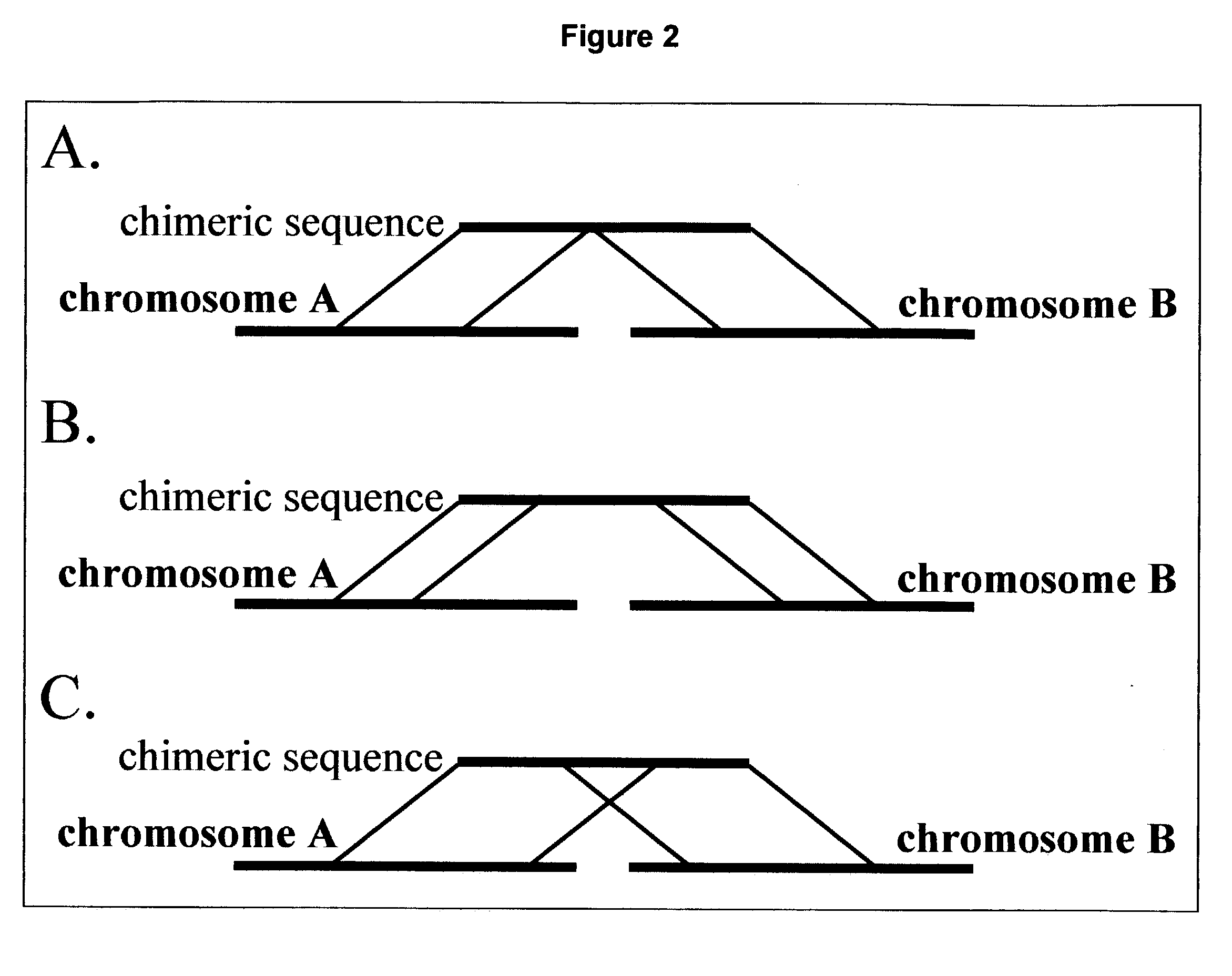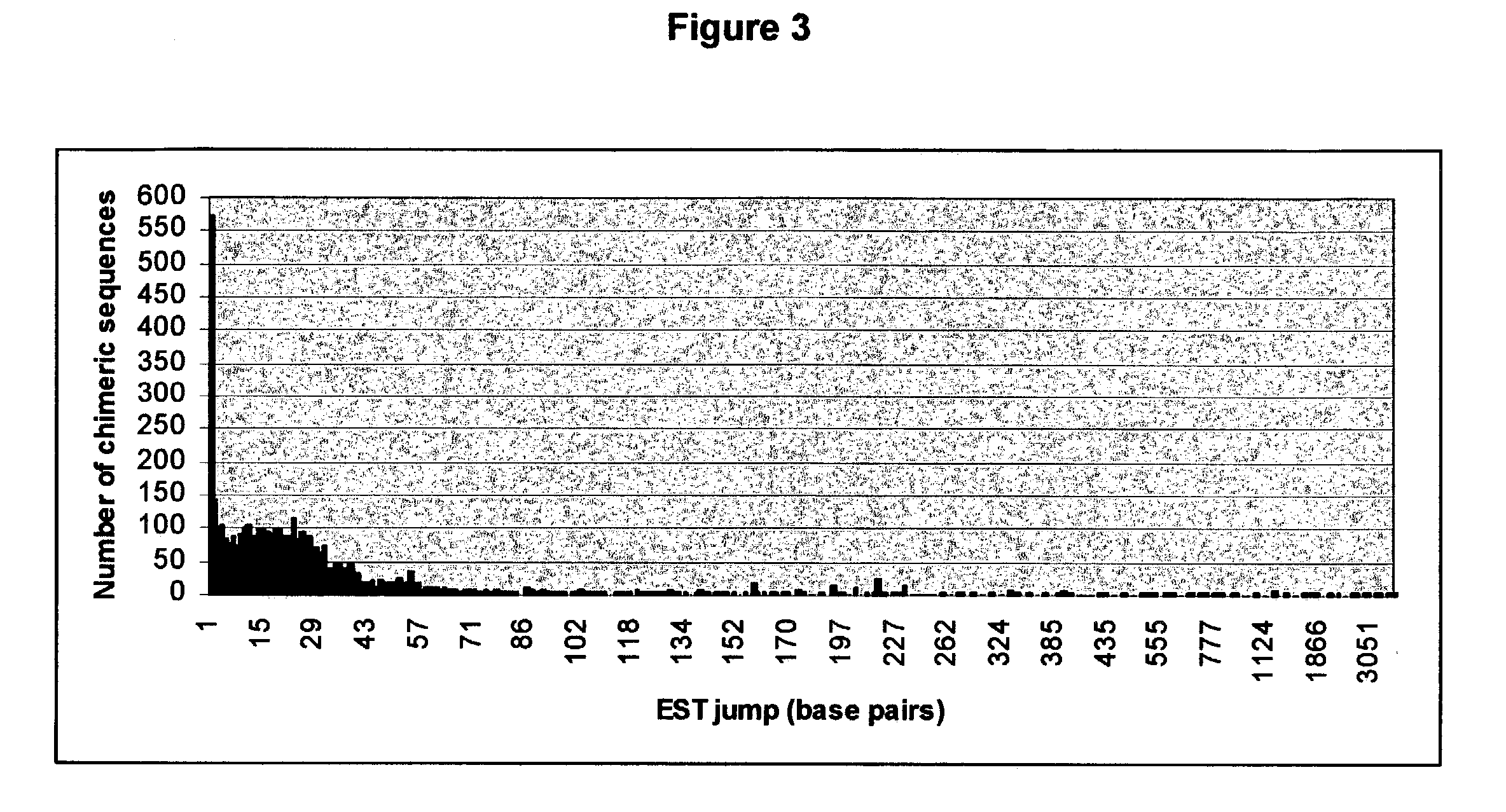Methods and systems for identifying putative fusion transcripts, polypeptides encoded therefrom and polynucleotide sequences related thereto and methods and kits utilizing same
a technology of putative fusion and polypeptides, applied in the field of methods and systems for identifying putative fusion transcripts, polypeptides encoded therefrom and polynucleotide sequences related thereto, and methods and kits utilizing same, can solve the problems of difficult culture of often not representing the original, and difficult to detect cells from many tumor types. , to achieve the effect of enabling the detection of structural aberrations involving less than 3-15
- Summary
- Abstract
- Description
- Claims
- Application Information
AI Technical Summary
Benefits of technology
Problems solved by technology
Method used
Image
Examples
example 1
Database Characterization
[0276] General Description of the Distribution of Chimeric Sequences and Chimeric Events in the Database--
[0277] (a) Total number of chimeric sequences: 13660
[0278] (i) ESTs: 12537
[0279] (ii) mRNAs: 1123
[0280] (b) Number of total participating contigs in the data: 10110
[0281] (c) Number of chimeric events: 11295
[0282] (i) Number of contig-contig cases: 6189
[0283] (ii) Number of contig-no contig cases 4069
[0284] (iii) Number of no-contig-no-contig cases: 1027
[0285] Distribution of sequences supporting chimeric events (Degree type 0)--The distribution of chimeric sequences supporting total chimeric events is illustrated in Table 1 below, wherein the column "#Sequences" denotes the number of chimeric sequences supporting the chimeric event and the column. "Events" denotes the number of chimeric events.
1 TABLE 1 # Sequences # Events 1 9988 2 966 3 173 4 62 5 26 6 20 7 9 8 7 9 4 10 4 11 2 12 4 13 2 14 2 17 4 19 1 20 2 22 1 24 1 25 2 28 1 31 2 40 1 51 1
[0286] The ...
example 2
"Hot Spot" Analysis Outline
[0310] Nucleic acid sequences at a transition point is tested for hotspot sequences. Hot spot sequences are particular areas of DNA, which are especially prone to spontaneous mutations or recombination. Defining a transition point sequences as hot spots supports the probability of a true fusion event.
[0311] Recurrence of chimeric events originating from the analysis of different tissue samples is indicative of a significant chimeric event Different degrees of significance were attributed to different analysis methods of fusion events (degree 0 to degree 3).
[0312] Degree-0--refers to the number of ESTs or the number of cDNA libraries supporting a single chimeric event.
[0313] Degree 1--refers to the number of chimeric events occurring between two contigs (gene)
[0314] Degree 2--refers to the number of chimeric events occurring between a certain contig and a set of different contigs.
[0315] Degree-3--refers to the number of chimeric events occurring in a certai...
example 3
Identification of False Positive Fusion Transcripts Resultant of Library Construction
[0324] Identification of chimeric events generated during cDNA library construction includes in the first step a search for break points / EST-JUMPs in sequences relevant for library production like restriction enzymes recognition sequences, artificial adaptors, docking primer and stretches of adenosine or thymidine (A / T), which might represents the Oligo-dT used for first strand synthesis. The second step is to look for fusion transcripts that exhibit two different directional splicing, such that the canonical splice site GT-AG, GC-AG and AT-AC is identified on one sequence end and the opposite sequences CT-AC, CT-GC and GT-AT is identified on the other end. The third step is designated a "multi allelic event" and relates to the analysis of the Degree-2 level. It will be appreciated that when a certain gene that creates fusion transcripts with more than two different genes in a single library can be ...
PUM
| Property | Measurement | Unit |
|---|---|---|
| temperature | aaaaa | aaaaa |
| temperature | aaaaa | aaaaa |
| pH | aaaaa | aaaaa |
Abstract
Description
Claims
Application Information
 Login to View More
Login to View More - R&D
- Intellectual Property
- Life Sciences
- Materials
- Tech Scout
- Unparalleled Data Quality
- Higher Quality Content
- 60% Fewer Hallucinations
Browse by: Latest US Patents, China's latest patents, Technical Efficacy Thesaurus, Application Domain, Technology Topic, Popular Technical Reports.
© 2025 PatSnap. All rights reserved.Legal|Privacy policy|Modern Slavery Act Transparency Statement|Sitemap|About US| Contact US: help@patsnap.com



